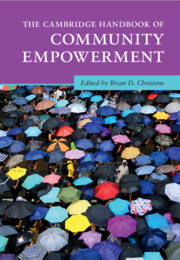Book contents
- The Cambridge Handbook of Community Empowerment
- Cambridge Handbooks in Psychology
- The Cambridge Handbook of Community Empowerment
- Copyright page
- Contents
- Figures
- Tables
- Contributors
- Building Community Power
- Part I Organizing and Activism
- Part II Participatory Governance
- Part III Civil Society and Coalitions
- Part IV Enterprise
- Part V Participatory and Community Arts
- Part VI Education and Engaged Research
- 20 Action Civics
- 21 Gender–Sexuality Alliances
- 22 Youth Participatory Action Research in School Settings
- 23 Community-Based Education
- 24 Community-Engaged Research
- Concluding Thoughts on Building Community Power
- Contributor Details
- Index
- References
22 - Youth Participatory Action Research in School Settings
from Part VI - Education and Engaged Research
Published online by Cambridge University Press: 18 April 2024
- The Cambridge Handbook of Community Empowerment
- Cambridge Handbooks in Psychology
- The Cambridge Handbook of Community Empowerment
- Copyright page
- Contents
- Figures
- Tables
- Contributors
- Building Community Power
- Part I Organizing and Activism
- Part II Participatory Governance
- Part III Civil Society and Coalitions
- Part IV Enterprise
- Part V Participatory and Community Arts
- Part VI Education and Engaged Research
- 20 Action Civics
- 21 Gender–Sexuality Alliances
- 22 Youth Participatory Action Research in School Settings
- 23 Community-Based Education
- 24 Community-Engaged Research
- Concluding Thoughts on Building Community Power
- Contributor Details
- Index
- References
Summary
Youth participatory action research (YPAR) engages youth in systematic processes of collectively identifying, analyzing, and addressing systems-level stressors, such as policies or practices that create unequal opportunities for young people to live, learn, and thrive. In this chapter, we first provide an overview of the history of YPAR. Next, we discuss key dimensions of power and empowerment within the YPAR process. Specifically, we explore YPAR in the context of educational settings via three case examples (i.e., a leadership class, a school club, and an after-school program). Lastly, applications of YPAR and future research are discussed.
- Type
- Chapter
- Information
- The Cambridge Handbook of Community Empowerment , pp. 556 - 579Publisher: Cambridge University PressPrint publication year: 2024

